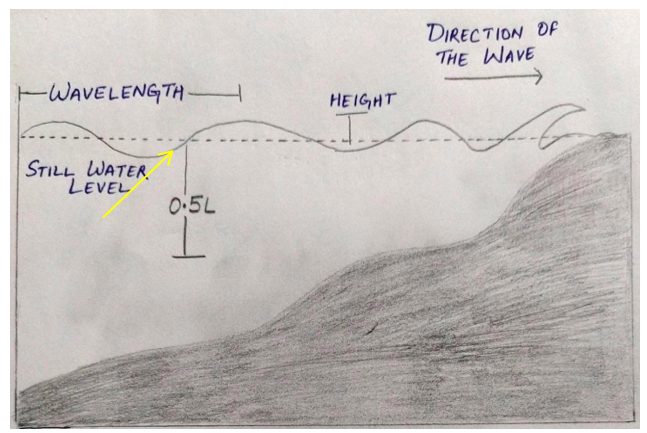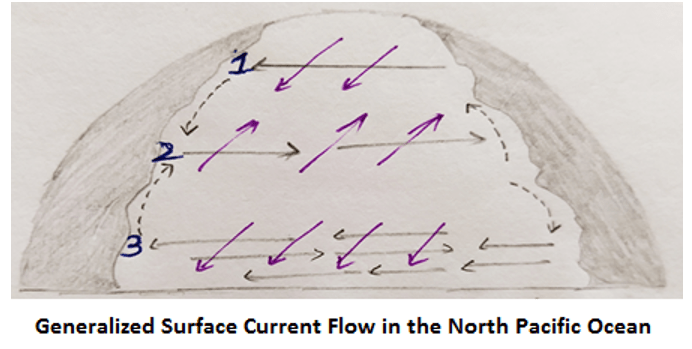This set of Marine Biotechnology Multiple Choice Questions & Answers (MCQs) focuses on “Ocean Habitat – Set 4”.
1. The marked region in the figure is ______________________

a) Wave trough
b) Wave crest
c) Wave height
d) Water level
View Answer
Explanation: The marked region is the wave trough and the corresponding wave rise is called the wave crest. One wavelength consists of a wave crest and a wave trough. The picture represents wave form and pattern of water motion in a deep-water wave.
2. In the figure below 1, 2 and 3 represents?

a) Polar easterlies, westerlies and south-pacific gyre
b) Polar easterlies, westerlies and trade winds
c) Trade winds, polar easterlies and westerlies
d) Trade winds, westerlies and polar easterlies
View Answer
Explanation: The dotted arrows in the figure indicate continental boundary currents and the solid arrows indicate wind-driven currents. Trade winds prevail at and near the equator, westerlies on the sub equatorial regions and polar easterlies on the North and the South poles.
3. The solar tide is larger than the lunar tide.
a) True
b) False
View Answer
Explanation: Tides occurring due to gravitational attraction of the Sun are one half as large as those occurring due to Moon’s gravitational attraction. Solar tides are not expressed as separate set of tides rather as a variation of basic lunar tidal pattern.
4. The neritic zone is photic whereas oceanic zone is aphotic.
a) True
b) False
View Answer
Explanation: The pelagic division refers to the entire water mass of the ocean, which can be further divided into neritic and oceanic provinces. Penetration of sunlight depends on the turbidity and not on the pelagic division.
5. Infauna refers to the organisms living in ___________________
a) water column
b) intertidal zone
c) on the sea botton
d) seafloor sediment
View Answer
Explanation: The benthos includes all the epifauna and infauna which are the organisms living on the sea bottom and in the sediment of the seafloor respectively. Benthic plants are usually restricted to intertidal regions and seafloor that lies within the photic zone.
6. Which of the following kind of marine organism cannot swim against strong currents?
a) Plankton
b) Nekton
c) Benthos
d) Invertebrates
View Answer
Explanation: Marine organisms are broadly classified as benthos, nekton and plankton. The word “Plankton” is derived from the Greek word planktos which means wandering. Planktonic organisms are defined by their inability to move against strong currents.
7. In the neap tides, the solar tide __________ the effect of the lunar tide.
a) boosts
b) diminishes
c) cancels
d) does not affect
View Answer
Explanation: One week after the spring tides, the Sun and Moon are at right angles to each other with respect to Earth. The neap tides that occur during this period arise due to the solar tide canceling out the effects of the lunar tide.
8. In a lunar month, ____ spring tides and _____ neap tides occur.
a) 1, 1
b) 1, 2
c) 2, 1
d) 2, 2
View Answer
Explanation: The duration of one lunar day is 24 hours 50 minutes, and one lunar month is measured between two successive new moons. During each lunar month, two spring tides and two neap tides occur.
Sanfoundry Global Education & Learning Series – Marine Biotechnology.
To practice all areas of Marine Biotechnology, here is complete set of 1000+ Multiple Choice Questions and Answers.
If you find a mistake in question / option / answer, kindly take a screenshot and email to [email protected]
